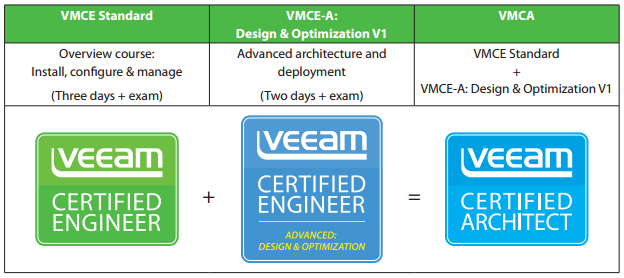This post is also available in: Italian
Reading Time: 2 minutesThe Veeam® Certified Architect (VMCA) certification is the highest level of Veeam technical certification and was introduced in 2016 (initially based on v8 of the product, but now it include also v9 and v9.5).
It require an exisisting Veeam Certified Engineer (VMCE) certification and also complete the Veeam Certified Engineer – Advanced: Design & Optimization (VMCE-ADO) training and exam:
The VMCE-A: Design & Optimization V1 traning is a two-day technical course focused on teaching engineers how to design and optimize Veeam Availability Suite™, following Veeam Solutions Architects best practices. The course covers Veeam Availability Suite™ design and optimization and the class is designed for those who have already taken the three-day VMCE Standard course and want to acquire the Veeam Certified Architect (VMCA) designation.
The VMCE-A1: D&O exam includes 40 randomized questions from each of the course modules, that are:
- Design and sizing
- Infrastructure assessment
- Security
- Optimization
- Automation
- Audit and compliance
- Troubleshooting
Aim for the VMCA title and comply with some of the certifications requirements for Platinum ProPartners and Veeam Accredited Service Partners (VASPs), but also permito to gain professional advantage with the highest level of Veeam technical certification and aim for career advancement.
VMCA certification has also a lifetime, like VMCE, and in order to keep it update you have to:
- Maintain a valid VMCE certificate on the latest version (v9)
- Maintain a valid VMCE-A certificate on the latest version (v1)
So it seems more restrictive compared to VMCE where you just need need to keept it updated on previous version (and have a simplified on-line short exam for update it to latest major version). But actually we don’t know how oftern will be released a new VMCE-A: Design & Optimization “version” (numbers are actually different, and it start just from v1).
See also:





